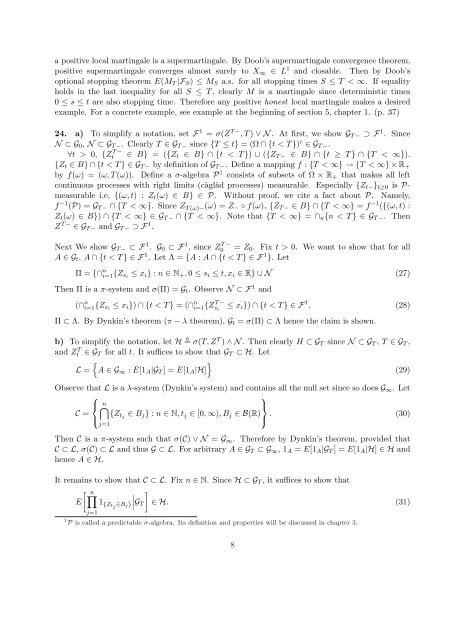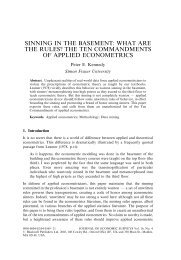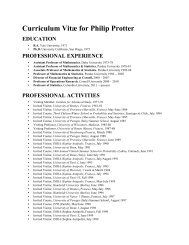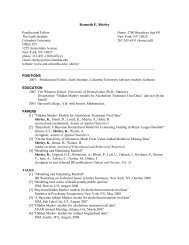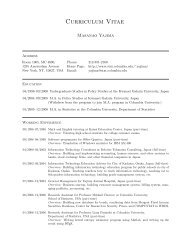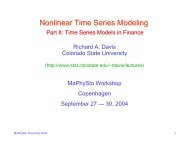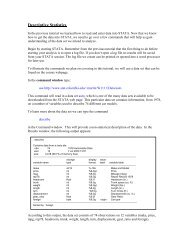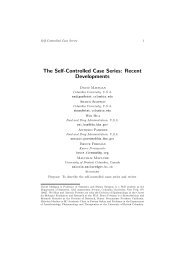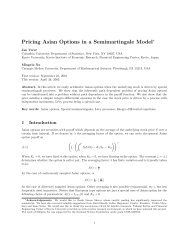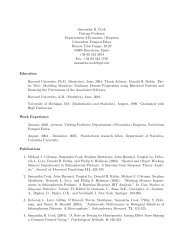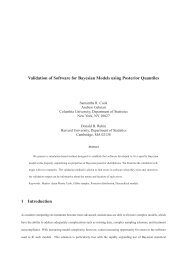Solution to selected problems.
Solution to selected problems.
Solution to selected problems.
Create successful ePaper yourself
Turn your PDF publications into a flip-book with our unique Google optimized e-Paper software.
a positive local martingale is a supermartingale. By Doob’s supermartingale convergence theorem,<br />
positive supermartingale converges almost surely <strong>to</strong> X ∞ ∈ L 1 and closable. Then by Doob’s<br />
optional s<strong>to</strong>pping theorem E(M T |F S ) ≤ M S a.s. for all s<strong>to</strong>pping times S ≤ T < ∞. If equality<br />
holds in the last inequality for all S ≤ T , clearly M is a martingale since deterministic times<br />
0 ≤ s ≤ t are also s<strong>to</strong>pping time. Therefore any positive honest local martingale makes a desired<br />
example. For a concrete example, see example at the beginning of section 5, chapter 1. (p. 37)<br />
24. a) To simplify a notation, set F 1 = σ(Z T − , T ) ∨ N . At first, we show G T − ⊃ F 1 . Since<br />
N ⊂ G 0 , N ⊂ G T − . Clearly T ∈ G T − since {T ≤ t} = (Ω ∩ {t < T }) c ∈ G T − .<br />
∀t > 0, {Zt T − ∈ B} = ({Z t ∈ B} ∩ {t < T }) ∪ ({Z T − ∈ B} ∩ {t ≥ T } ∩ {T < ∞}).<br />
{Z t ∈ B} ∩ {t < T } ∈ G T − by definition of G T − . Define a mapping f : {T < ∞} → {T < ∞} × R +<br />
by f(ω) = (ω, T (ω)). Define a σ-algebra P 1 consists of subsets of Ω × R + that makes all left<br />
continuous processes with right limits (càglàd processes) measurable. Especially {Z t− } t≥0 is P-<br />
measurable i.e, {(ω, t) : Z t (ω) ∈ B} ∈ P. Without proof, we cite a fact about P. Namely,<br />
f −1 (P) = G T − ∩ {T < ∞}. Since Z T (ω)− (ω) = Z − ◦ f(ω), {Z T − ∈ B} ∩ {T < ∞} = f −1 ({(ω, t) :<br />
Z t (ω) ∈ B}) ∩ {T < ∞} ∈ G T − ∩ {T < ∞}. Note that {T < ∞} = ∩ n {n < T } ∈ G T − . Then<br />
Z T − ∈ G T − and G T − ⊃ F 1 .<br />
Next We show G T − ⊂ F 1 . G 0 ⊂ F 1 , since Z T −<br />
0 = Z 0 . Fix t > 0. We want <strong>to</strong> show that for all<br />
A ∈ G t , A ∩ {t < T } ∈ F 1 . Let Λ = {A : A ∩ {t < T } ∈ F 1 }. Let<br />
Π = {∩ n i=1{Z si ≤ x i } : n ∈ N + , 0 ≤ s i ≤ t, x i ∈ R} ∪ N (27)<br />
Then Π is a π-system and σ(Π) = G t . Observe N ⊂ F 1 and<br />
(∩ n i=1{Z si ≤ x i }) ∩ {t < T } = (∩ n i=1{Z T −<br />
s i<br />
≤ x i }) ∩ {t < T } ∈ F 1 , (28)<br />
Π ⊂ Λ. By Dynkin’s theorem (π − λ theorem), G t = σ(Π) ⊂ Λ hence the claim is shown.<br />
b) To simplify the notation, let H σ(T, Z T ) ∧ N . Then clearly H ⊂ G T since N ⊂ G T , T ∈ G T ,<br />
and Zt<br />
T ∈ G T for all t. It suffices <strong>to</strong> show that G T ⊂ H. Let<br />
{<br />
}<br />
L = A ∈ G ∞ : E[1 A |G T ] = E[1 A |H]<br />
(29)<br />
Observe that L is a λ-system (Dynkin’s system) and contains all the null set since so does G ∞ . Let<br />
⎧<br />
⎫<br />
⎨ n⋂<br />
⎬<br />
C = {Z tj ∈ B j } : n ∈ N, t j ∈ [0, ∞), B j ∈ B(R)<br />
⎩<br />
⎭ . (30)<br />
j=1<br />
Then C is a π-system such that σ(C) ∨ N = G ∞ . Therefore by Dynkin’s theorem, provided that<br />
C ⊂ L, σ(C) ⊂ L and thus G ⊂ L. For arbitrary A ∈ G T ⊂ G ∞ , 1 A = E[1 A |G T ] = E[1 A |H] ∈ H and<br />
hence A ∈ H.<br />
It remains <strong>to</strong> show that C ⊂ L. Fix n ∈ N. Since H ⊂ G T , it suffices <strong>to</strong> show that<br />
[<br />
∏ n ]<br />
∣<br />
E<br />
∣G T ∈ H. (31)<br />
j=1<br />
1 {Ztj ∈B j }<br />
1 P is called a predictable σ-algebra. Its definition and properties will be discussed in chapter 3.<br />
8


